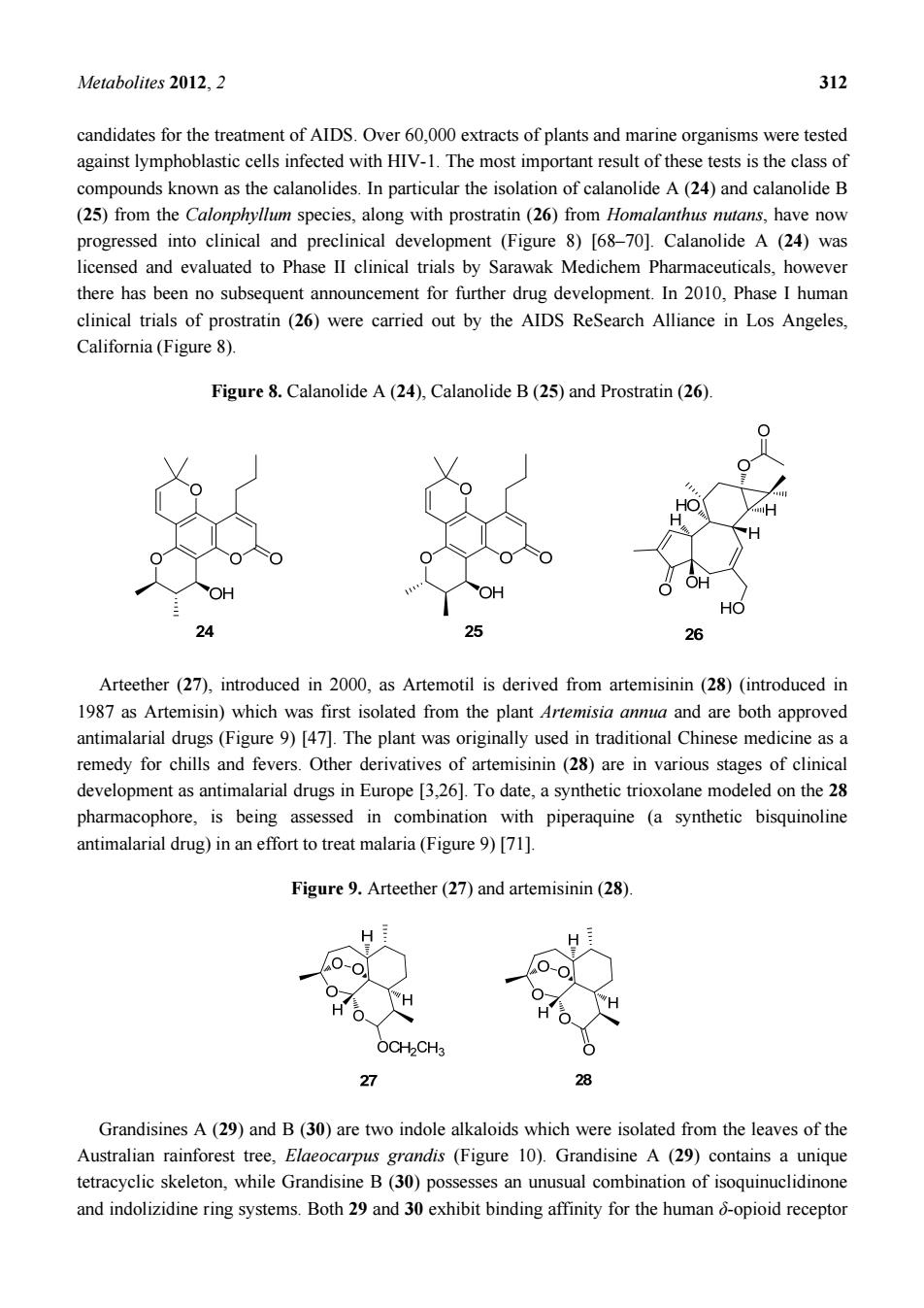正在加载图片...

Metabolites 2012.2 312 candidates for the treatment of AIDS.Over 60,000 extracts of plants and marine organisms were tested against lymphoblastic cells infected with HIV-1.The most important result of these tests is the class of compounds known as the calanolides.In particular the isolation of calanolide a (24)and calanolide b (25)from the Calonphyllum species,along with prostratin (26)from Homalanthus mtans,have now progressed into clinical and preclinical development (Figure 8)[68-70].Calanolide A (24)was licensed and evaluated to Phase II clinical trials by Sarawak Medichem Pharmaceuticals,however there has been no subsequent announcement for further drug development.In 2010.Phase I human clinical trials of prostratin (26)were carried out by the AIDS ReSearch Alliance in Los Angeles, California(Figure 8). Figure 8.Calanolide A(24),Calanolide B(25)and Prostratin(26). HO Arteether (27),introduced in 2000,as Artemotil is derived from artemisinin(28)(introduced in 1987 as Artemisin)which was first isolated from the plant Artemisia annua and are both approved antimalarial drugs (Figure 9)[47].The plant was originally used in traditional Chinese medicine as a remedy for chills and fevers.Other derivatives of artemisinin (28)are in various stages of clinical development as antimalarial drugs in Europe [3,26].To date,a synthetic trioxolane modeled on the 28 pharmacophore,is being assessed in combination with piperaquine (a synthetic bisquinoline antimalarial drug)in an effort to treat malaria(Figure 9)[71]. Figure 9.Arteether(27)and artemisinin(28) H H H Grandisines A (29)and B(30)are two indole alkaloids which were isolated from the leaves of the Australian rainforest tree,Elaeocarpus grandis (Figure 10).Grandisine A (29)contains a unique tetracyclic skeleton,while Grandisine B(30)possesses an unusual combination of isoquinuclidinone and indolizidine ring systems.Both 29 and 30 exhibit binding affinity for the human 6-opioid receptorMetabolites 2012, 2 312 candidates for the treatment of AIDS. Over 60,000 extracts of plants and marine organisms were tested against lymphoblastic cells infected with HIV-1. The most important result of these tests is the class of compounds known as the calanolides. In particular the isolation of calanolide A (24) and calanolide B (25) from the Calonphyllum species, along with prostratin (26) from Homalanthus nutans, have now progressed into clinical and preclinical development (Figure 8) [68–70]. Calanolide A (24) was licensed and evaluated to Phase II clinical trials by Sarawak Medichem Pharmaceuticals, however there has been no subsequent announcement for further drug development. In 2010, Phase I human clinical trials of prostratin (26) were carried out by the AIDS ReSearch Alliance in Los Angeles, California (Figure 8). Figure 8. Calanolide A (24), Calanolide B (25) and Prostratin (26). Arteether (27), introduced in 2000, as Artemotil is derived from artemisinin (28) (introduced in 1987 as Artemisin) which was first isolated from the plant Artemisia annua and are both approved antimalarial drugs (Figure 9) [47]. The plant was originally used in traditional Chinese medicine as a remedy for chills and fevers. Other derivatives of artemisinin (28) are in various stages of clinical development as antimalarial drugs in Europe [3,26]. To date, a synthetic trioxolane modeled on the 28 pharmacophore, is being assessed in combination with piperaquine (a synthetic bisquinoline antimalarial drug) in an effort to treat malaria (Figure 9) [71]. Figure 9. Arteether (27) and artemisinin (28). Grandisines A (29) and B (30) are two indole alkaloids which were isolated from the leaves of the Australian rainforest tree, Elaeocarpus grandis (Figure 10). Grandisine A (29) contains a unique tetracyclic skeleton, while Grandisine B (30) possesses an unusual combination of isoquinuclidinone and indolizidine ring systems. Both 29 and 30 exhibit binding affinity for the human δ-opioid receptor